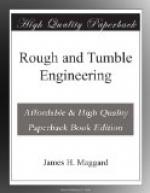Q. How would you start your engine after it had been standing over night? A. Slowly.
Q. Why? A. In order to allow the cylinder to become hot, and that the water or condensed steam may escape without injury to the cylinder.
Q. What is the last thing to do at night? A. See that there is plenty of water in boiler, and if the weather is cold drain all pipes.
Q. What care should be taken of the fusable plug? A. Keep it scraped clean, and not allow it to become corroded on top.
Q. What is a fusible plug? A. It is a hollow cast plug screwed into the crown sheet or top of fire box, and having the hollow or center filled with lead or babbit.
Q. Is such a plug a protection to a boiler?
A. It is if kept in proper condition.
Q. Can you explain the principle of the fusible or soft plug as it is sometimes called? A. It is placed directly over the fire, and should the water fall below the crown sheet the lead fuses or melts and allows the steam to flow down on top of the fire, destroys the heat and prevents the burning of crown sheet.
Q. Why don’t the lead fuse with water over it? A. Because the water absorbs the heat and prevents it reaching the fusing point.
Q. What is the fusing point of lead?
A. 618 degrees.
Q. Is there any objection to the soft plug?
A. There is, in the hands of some engineers.
Q. Why?
A. It relieves him of the fear of a dry crown sheet,
and gives
him an apparent excuse for low water.
Q. Is this a real or legitimate objection?
A. It is not.
Q. What are the two distinct classes of boilers?
A. The externally and internally fired boilers.
Q. Which is the most economical?
A. The internally fired boiler.
Q. Why? A. Because the fuel is all consumed in close contact with the sides of furnace and the loss from radiation is less than in the externally fired.
Q. To what class does the farm or traction engine
belong?
A. To the internally fired.
Q. How would you find the H.P. of such a boiler? A. Multiply in inches the circumference or square of furnace, by its length, then multiply, the circumference of one tube by its total length, and this product by the number of tubes also taking into account the surface in tube sheet, add these products together and divide by I44, this will give you the number of square feet of heating surface in boiler. Divide this by 14 or 15 which will give the H.P. of boiler.
Q. Why do you say 14 or 15? A. Because some claim that it requires 14 feet of heating surface to the H.P. and others 15. To give you my personal opinion I believe that any of the standard engines today with good coal and properly handled, will and are producing 1 H.P. for as low as every 10 feet of surface. But to be on the safe side it is well to divide by 15 to get the H.P. of your boiler, when good and bad fuel is considered.




